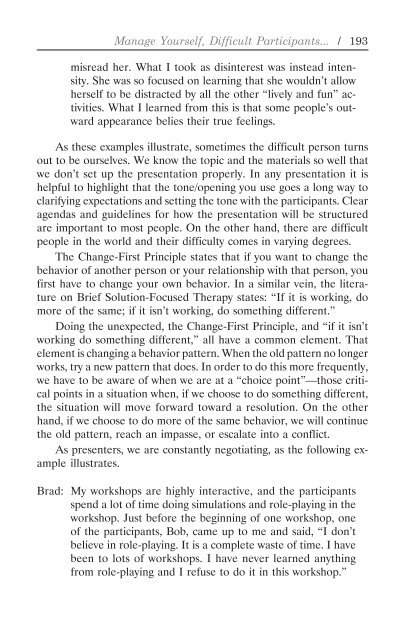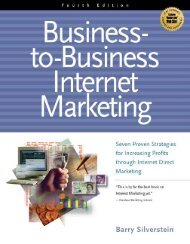The Seven Strategies of Master Presenters - Lifecycle Performance ...
The Seven Strategies of Master Presenters - Lifecycle Performance ...
The Seven Strategies of Master Presenters - Lifecycle Performance ...
You also want an ePaper? Increase the reach of your titles
YUMPU automatically turns print PDFs into web optimized ePapers that Google loves.
Manage Yourself, Difficult Participants... / 193<br />
misread her. What I took as disinterest was instead intensity.<br />
She was so focused on learning that she wouldn’t allow<br />
herself to be distracted by all the other “lively and fun” activities.<br />
What I learned from this is that some people’s outward<br />
appearance belies their true feelings.<br />
As these examples illustrate, sometimes the difficult person turns<br />
out to be ourselves. We know the topic and the materials so well that<br />
we don’t set up the presentation properly. In any presentation it is<br />
helpful to highlight that the tone/opening you use goes a long way to<br />
clarifying expectations and setting the tone with the participants. Clear<br />
agendas and guidelines for how the presentation will be structured<br />
are important to most people. On the other hand, there are difficult<br />
people in the world and their difficulty comes in varying degrees.<br />
<strong>The</strong> Change-First Principle states that if you want to change the<br />
behavior <strong>of</strong> another person or your relationship with that person, you<br />
first have to change your own behavior. In a similar vein, the literature<br />
on Brief Solution-Focused <strong>The</strong>rapy states: “If it is working, do<br />
more <strong>of</strong> the same; if it isn’t working, do something different.”<br />
Doing the unexpected, the Change-First Principle, and “if it isn’t<br />
working do something different,” all have a common element. That<br />
element is changing a behavior pattern. When the old pattern no longer<br />
works, try a new pattern that does. In order to do this more frequently,<br />
we have to be aware <strong>of</strong> when we are at a “choice point”—those critical<br />
points in a situation when, if we choose to do something different,<br />
the situation will move forward toward a resolution. On the other<br />
hand, if we choose to do more <strong>of</strong> the same behavior, we will continue<br />
the old pattern, reach an impasse, or escalate into a conflict.<br />
As presenters, we are constantly negotiating, as the following example<br />
illustrates.<br />
Brad: My workshops are highly interactive, and the participants<br />
spend a lot <strong>of</strong> time doing simulations and role-playing in the<br />
workshop. Just before the beginning <strong>of</strong> one workshop, one<br />
<strong>of</strong> the participants, Bob, came up to me and said, “I don’t<br />
believe in role-playing. It is a complete waste <strong>of</strong> time. I have<br />
been to lots <strong>of</strong> workshops. I have never learned anything<br />
from role-playing and I refuse to do it in this workshop.”










